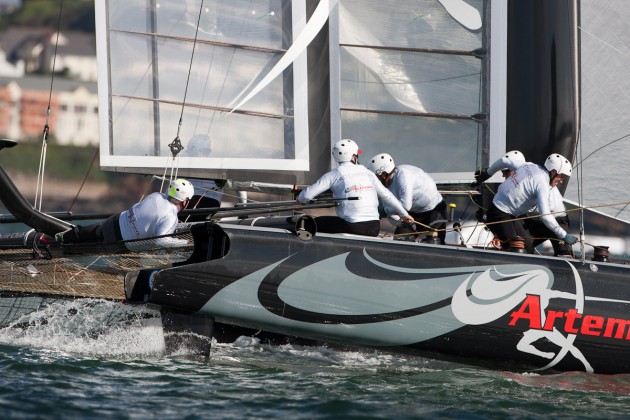Plans to commercialise the Cup through the World Series are stacked against a massive $300 million investment
There’s no doubt the America’s Cup World Series in Plymouth last week was a popular success. But can it really be a commercial success as well? Given the scale of the investment and operation, I’m not so sure. This is one of the largest financial gambles in sailing history.
The concept is largely Russell Coutt’s vision of a means of commercialising the Cup by splicing it into a continuous, self-supporting circuit, and it is being done with no expense spared.
The man who has been taken on to oversee its transformation into a going concern is Richard Worth, chief executive of the America’s Cup Event Authority (ACEA). Worth’s background is in marketing the UEFA Champions League. Football also has its own billionaire investors yet generates huge revenues in its own right. Can the same be done with sailing?
The scale of the risk is breathtaking, considering the sums of money and the short runway involved. “From the start of the World Series to the end of the America’s Cup [in 2013], the total cost is in the hundreds of millions,” admits Worth. The figure, according to another ACEA source is around $300m. The investment in TV staff and equipment alone is said to run to $16m.
How is that funded? “The ACEA and the America’s Cup Race Management are effectively borrowing money from Oracle Team,” says Worth.
So ultimately, Larry Ellison is writing the cheque.
I ask Worth about the business plan for the World Series. “It would be normal in football to think of 80 per cent of the revenue coming from TV rights and 20 per cent from sponsorship. In sailing, I think it will be the other way round,” he says.
Raising money from venues to host the event has been a hard sell. Plymouth Council has estimated costs of set up and benefits of around £100-200,000 but there’s no suggestion that they paid directly for the event. “Plymouth made a leap of faith. Most cities would have told us to go away. It wasn’t the peak money, but we needed to get started,” admits Worth.
The latest city to join up, Naples, has paid for the privilege, says Worth. The figure is rumoured as €5 million plus benefits in kind. But only a few more venue slots are available before the America’s Cup proper kicks off. Other host cities are said to be paying a lot less and Auckland and Sydney turned deals down flat.
Worth hints that the event won’t return to Plymouth without payment next time and says he thinks research will show it was worth £10m. But for business investors, a question mark remains over the true value of yacht racing events.
Mark Turner, whose company OC ThirdPole runs the Extreme 40 circuit on which this is loosely modelled admits: “Most event organisers talk things up and there are enough vested interests [in the cities] to talk it up afterwards. But there’s no truly accurate way of measuring it because the research that’s done is often paid for by a stakeholder so it’s a bit skewed.”
Selling TV rights has also been proving difficult to kickstart. The World Series TV coverage, with production done to a phenomenal level, is free to view on YouTube. Worth says there are 26 contracts in place with broadcasters, but the only competing country to buy TV rights so far has been TV New Zealand and a broadcaster showing the action in the San Francisco area of the US.
TV rights brought in significant sums during the 32nd America’s Cup, but there’s no certainty that the World Series will replicate that. The marketing of the World Series as an entity bolted on to the America’s Cup has a downside: as spectators become more familiar with the format they realise that the racing is not in the same boats as the Cup, the teams aren’t the same and the Series points don’t count towards it. It’s not the real product: it’s a brand extension.
Some commentators argue that the event also that lacks two reliable drivers of global interest in sports: there are no really well-known personalities and, with the exception of Emirates Team New Zealand, no national interests.
The conundrum of commercialising the America’s Cup is that, to succeed, it needs to be developed over a long period of time, but its lack of consistency and changing format is a huge obstacle. For the last 150 years, that’s been the nature of the America’s Cup.
Tellingly, when I ask Richard Worth about his job commercialising the World Series, he shoots back: “I didn’t set that challenge. What we are trying to do is bridge the gap between America’s Cups with a brand that keeps it alive. Our springboard is not this two-year cycle but to make this something we can bounce off afterwards.”
He does not, he says, have an open cheque. “Maybe the costs will be higher than the income. At a certain point, life stops. After the America’s Cup is run the account must be closed and we’ll see if it’s a positive or a negative.”
Either way it won’t affect the America’s Cup itself. Like so much of sailing, from top to bottom, it rests on a resilient foundation of private wealth and personal passion. The business side is a layer on top of that. What’s being fought over here is how thick that layer can be made.




